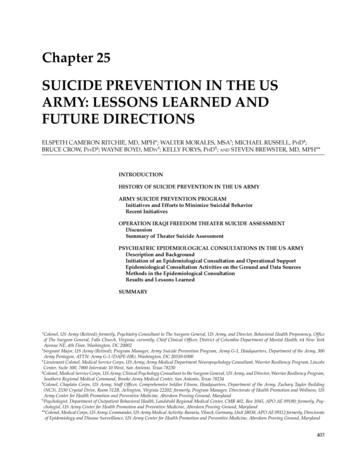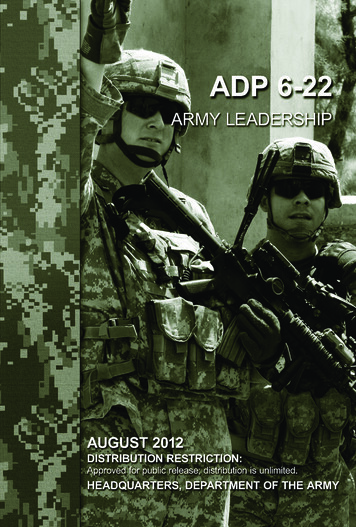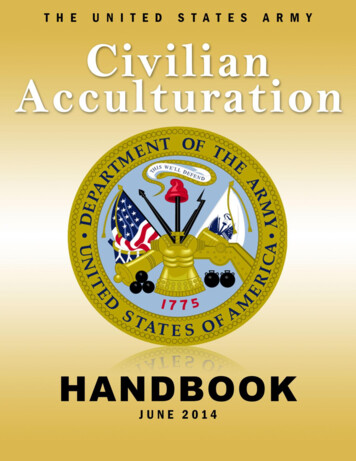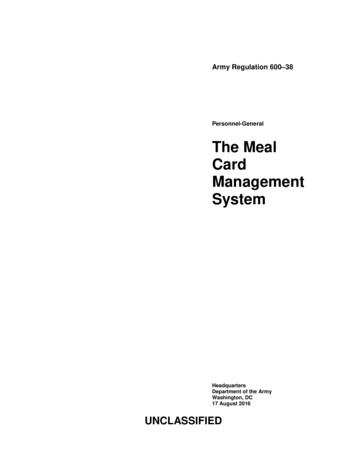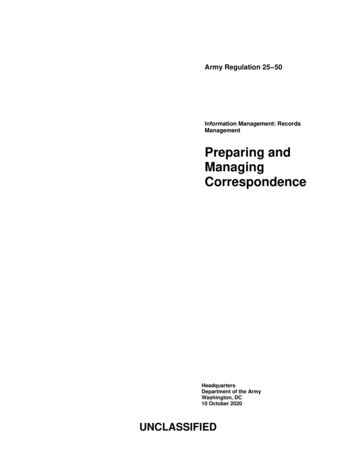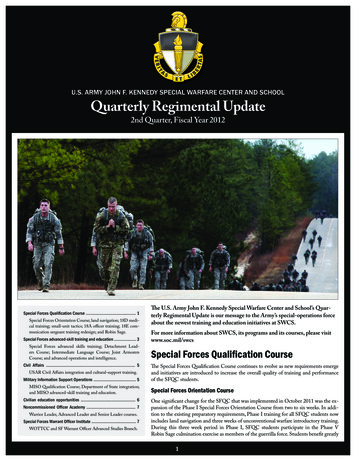
Transcription
U.S. ARMY JOHN F. KENNEDY SPECIAL WARFARE CENTER AND SCHOOLQuarterly Regimental Update2nd Quarter, Fiscal Year 2012Special Forces Qualification Course . 1Special Forces Orientation Course; land navigation; 18D medical training; small-unit tactics; 18A officer training; 18E communication sergeant training redesign; and Robin Sage.Special Forces advanced-skill training and education . 3Special Forces advanced skills training; Detachment Leaders Course; Intermediate Language Course; Joint ArmorersCourse; and advanced operations and intelligence.Civil Affairs . 5USAR Civil Affairs integration and cultural-support training.Military Information Support Operations . 5MISO Qualification Course; Department of State integration;and MISO advanced-skill training and education.Civilian education opportunities . 6Noncommissioned Officer Academy . 7Warrior Leader, Advanced Leader and Senior Leader courses.Special Forces Warrant Officer Institute . 7WOTTCC and SF Warrant Officer Advanced Studies Branch.The U.S. Army John F. Kennedy Special Warfare Center and School’s Quarterly Regimental Update is our message to the Army’s special-operations forceabout the newest training and education initiatives at SWCS.For more information about SWCS, its programs and its courses, please visitwww.soc.mil/swcsSpecial Forces Qualification CourseThe Special Forces Qualification Course continues to evolve as new requirements emergeand initiatives are introduced to increase the overall quality of training and performanceof the SFQC students.Special Forces Orientation CourseOne significant change for the SFQC that was implemented in October 2011 was the expansion of the Phase I Special Forces Orientation Course from two to six weeks. In addition to the existing preparatory requirements, Phase I training for all SFQC students nowincludes land navigation and three weeks of unconventional warfare introductory training.During this three week period in Phase I, SFQC students participate in the Phase VRobin Sage culmination exercise as members of the guerrilla force. Students benefit greatly1
SWCS Quarterly Regimental Update2nd Quarter, Fiscal Year 2012from this experience early in their SFQC training, and they depart Phase I with a foundation ofUW knowledge to build upon for the remainderof their SFQC training.Land NavigationIn order to support student success in PhaseIII Small Unit Tactics, 4th Battalion, 1st Special Warfare Training Group (Airborne) alsorevamped land-navigation training and testing.Land navigation was moved from the end ofPhase II Language to the beginning of Phase ISFOC. As students begin SFQC, they are givenland-navigation training followed by testing thatthey are required to pass in order to proceed inthe SFQC. Positive results from this initiativeare already visible. In land navigation, 758 students have been tested with only 39 studentsthat did not meet the standard, which equates toa 95-percent success rate for land navigation. InSUT, 375 students have received training withonly 71 students who either failed to meet thestandards or were injured during training, equating to an 81-percent success rate in SUT. Thesefigures illustrate an increase of approximately 5to 10-percent pass rate from historical data.Special Forces Medical TrainingThe Special Warfare Medical Group (Airborne)has recently undergone several significant changes and additions that improve the quality ofmedical training and education for the joint force.The first quarter of Fiscal Year 2012 marked thesuccessful start of the new 36-week Special Operations Combat Medic course, as well as the firstissuance of iPad and Galaxy tablets to students.With SWMG(A)’s continued development program, students and instructors are continuouslyexposed to the latest techniques in relevant battlefield medicine. Through partnerships with otherworld-class medical facilities, a robust guestspeaker program and input from medical conferences across the nation, SWMG(A) continues toprovide the most advanced medical training andproduce the most qualified SOF medics.Special Operations Combat Medic Courseand Special Forces 18D MOS phase: The newSOCM course is a significant improvement toprevious courses. To begin with, the course hasbeen expanded from 24 to 36 weeks in lengthto include several blocks that were previouslytaught only in the Special Forces 18D MedicalSergeants and Special Operations IndependentDuty Corpsman courses. This means that allSOCM medics across the regiments will uniformly possess more advanced skills than everbefore. Secondly, the expansion of SOCM hasreduced the length of SFMS and SOIDC from24 to 16 weeks, allowing future 18Ds to synchronize with the rest of the SFQC. In this redesigned course, all future 18D students attend thesame SFQC phases as students from the otherSpecial Forces MOS phases. This allows studentsto maintain their instructor-operational detach-Special Forces Qualification Course students participate in the Small Unit Tactics phase of the SFQC. Management of SUT was recently transferred tothe control of 4th Battalion, 1st SWTG(A) in order to allow instructor operational detachment-alpha instructors to oversee the training.ment—alpha composition and have the samemedic throughout all phases of the SFQC.Life-long learning for medics: In addition to improved quality and synchronization, SWMG(A)has recently issued iPad and Galaxy tablets tostudents. This benefit allows students to accessthe Learning Management System and other educational applications that will enhance the consistency and quality of classroom instruction. Asstudents graduate and serve across the Regiment,the tablets allow all SOCM and 18D students to“reach back” to the schoolhouse for the latest andmost advanced training and lessons-learned. Notto mention, all medics will have their entire catalog of books, classes and reading materials permanently stored on their device. Dragging trunkloads of books from deployment to deploymentwill be a thing of the past.Small Unit TacticsIn December 2011, the 1st SWTG(A) Commander approved the transfer of responsibility of Phase III SUT from 1st Battalion to 4thBattalion. The impetus for this decision was tostreamline the training given to students in SUT.The IODA concentrated much of their effortduring SFQC Phase II Language training onpreparing students for SUT. While in SUT, theIODA instructors served as the primary instructors for their students, which drove the change tohave 4th Battalion, 1st SWTG(A) have overallresponsibility for this phase of training. The battalion was then reorganized to execute the SUTmission and established the SUT Company as BCompany, 4th Battalion at Camp Mackall.Special Forces Detachment Commander18A MOS Phase2The 18A MOS phase recently introduced social media into the unconventional warfare PilotTeam field-training exercise using sites such asFacebook and Twitter to provide in-role feedbackto the students. This provided the students moretools which could realistically be leveraged duringa UW campaign, while supporting a conventional option or UW as a stand-alone strategic option. These tools, as evidenced by the events of theArab Spring, were the primary engines of changerather than overt, armed conflict. The companyleadership instituted controls and appropriateoversight to ensure that the students did not usenor reveal any operational tactics, techniques orprocedures through these mediums.Special Forces Communication Sergeant18E MOS Phase RedesignThe 18E phase of SFQC training is undergoing aredesign to address methods to continue producing the most qualified and capable Special Forcescommunicators. SFQC training for 18E studentshas increased their ability to employ and accessSpecial Forces, joint and interagency communication systems.18E Redesign: Several key factors have beenidentified to ensure high-quality 18Es continueto be produced: Maintain a competitive advantage withemerging or developing technologies andtheir operational employment in a complexoperational environment. Ensure the most relevant 18E course content with relevant equipment and contemporary employment (current and future tactics, techniques and procedures) is provided.
SWCS Quarterly Regimental Update2nd Quarter, Fiscal Year 2012The Special Forces Advanced Mountain Operations School, now a part of the U.S. Army John F. Kennedy Special Warfare Center and School, is based out of Fort Carson, Co. The school’s courses include the newly created SeniorMountaineering Course and the Master Mountaineering Course. The SFAMOS is the U.S. Army Special Operations Command proponent for advanced mountaineering, high-altitude and cold-weather operations. Leverage special-operations forces and theinteragency community (funding, materialsupport, and technical expertise) to becomemutually supporting endeavors that supportand enhance 18E training exercises, RobinSage and other 1st SWTG(A) initiatives.Redesigned 18E program of instruction implementation: Beginning in February 2012, 18Etraining will implement the redesigned POIwhich includes an additional two weeks of training in Phase IV. Additions to the curriculuminclude training on the PRC-150 HF/ALE 3Gradio set, the integration of the SDN-L(VX)with the PRC-117G BGAN, and COMP TIAcertification preparation instruction. The nearterm goal is to integrate these systems and training through the 18E field-training exercise, MaxGain, and Robin Sage. As the necessary equipment and trained instructors are introduced intothe 18E phase (goal is 4th quarter, FY12), anadditional two weeks of training will be added,which will extend the phase once again for a totalof 18 weeks of 18E training during Phase IV ofthe SFQC.Robin SageWith support from the Combating TerrorismTechnical Support Office, an initial proof-ofconcept was performed in December 2011 using Palantir Technologies platforms via smartphones in support of the Robin Sage exercise. Inaddition, Phase V cadre also received a demonstration of the DTCS system (an Iridium-basedcommunication and GPS-tracker system). Thedemonstration was a great opportunity for cadreand instructors within 1st SWTG(A) to view thesystem’s capabilities. As a result, an expanded rolefor the Palantir and DTCS systems to providereal-time communications, battle tracking, andscenario support will be explored in March 2012.Palantir Technologies will also work closely withthe 18A cadre to provide a similar product thatexpands on existing exercise support mechanismsand systems. This collaboration and support fromthe CTTSO office is proving beneficial to provide better cadre tools to facilitate the trainingand improve the overall quality of training forSFQC students.Special Forces AdvancedTraining and EducationSpecial Forces advanced-skill training and education has progressed throughout the durationof the 1st Quarter, Fiscal Year 12 with advancements not only in equipment, but also in trainingof tactical skill sets and education.Special Forces Advanced SkillsSpecial Forces Advanced Mountain Operations School: The SFAMOS has transitionedto SWCS control from the U.S. Army SpecialForces Command (Airborne). This transitionresulted in adding two additional courses, theSenior Mountaineering Course and the MasterMountaineering Course, to the SWCS inventory.SFAMOS is the U.S. Army Special OperationsCommand proponent for advanced mountaineering, high-altitude and cold-weather operations, thus making them the lead componentwithin the U.S. Special Operations Commandfor military mountaineering.Military Free-Fall School: The MFFS has instituted new combat equipment (combat helmet,body armor, center-mounted weapons harness)into the Military Free-Fall Parachutist Course.The MFFPC is also in the process of increasing3throughput of course graduates from 560 to 1026per-FY to accommodate the training of SFQCgraduates prior to them arriving to their assignedgroups (projected expansion will begin in 3rdQuarter, FY12).Special Forces Sniper Course: Advanced tactical skills has increased throughput of the SpecialForces Sniper Course by 20 percent, while simultaneously advancing long-distance lethalitythroughout the Special Forces regiment via incorporation of new small-arms and optics technologies. In December 2011, the SFSC hostedthe 2011 USASOC Sniper Competition atRange 37 on Fort Bragg, N.C. The competitionwas four days in duration with 12 events designedto physically and mentally challenge sniper teamsfrom USASOC CSCs (active and guard), MARSOC, NAVSOC, U.S. Army Sniper School,USMC Scout Sniper School, selected federaland state law-enforcement agencies, and selectedforeign teams (Canadian SOF and Dutch SF).Out of the 32 sniper teams that competed, thetop five teams were from USASOC, Dutch SF,10th SFG(A), and 1st SFG(A).Detachment Leaders CourseSpecial Forces regimental cooperation is increasing throughout 1st SWTG(A), which hasdirectly influenced the quality of instruction inthe DLC and preparedness of newly-graduated18As as they transition from 1st SWTG(A) totheir operational assignments. DLC studentsbenefit greatly from interacting with senior leaders as guest speakers and being able to VTC withforward headquarters and better understand theCOE. The SWCS Commanding General has recently authorized the expansion of the DLC toinclude Civil Affairs and Military InformationSupport Operations officers, along with Special
SWCS Quarterly Regimental UpdateForces warrant officers and senior Special ForcesNCOs slated for operational detachment-alphateam sergeant positions. To accommodate the addition of CA and MISO officers, the course hasincreased its capacity to allow up to 40 studentsto attend each class. The April 2012 DLC will bethe first class to integrate other regiments withapproximately five MISO officers attending thecourse.Intermediate Language CourseSWCS graduated its first non-pilot IntermediateLanguage Course class in February 2012. ILCstudents in this class learned Pashtu, Russian,Modern Standard Arabic, Dari or Chinese Mandarin at the 2/2 levels of oral proficiency.The ILC curriculum offers Pashtu, Urdu, Dari,Farsi, Arabic, Russian, and Chinese Mandarininstruction available for all ARSOF Soldiers whohave a 1 /1 in either the Oral Proficiency Interview or the Defense Language Proficiency Test.ILC students may expect to achieve 2/2 levelsin participatory and conversational speaking andlistening capabilities.The language portion of ILC is up to 32 weeks inlength at Fort Bragg, though students frequentlytest out early and go on (or back) to their unitsonce they achieve 2/2 levels of proficiency. Sending Soldiers to the ILC greatly increases ARSOFSoldiers’ capabilities in meeting the directive inachieving one-third of the force at 2/2 levels oflanguage competency.2nd Quarter, Fiscal Year 2012SWTG(A) in June 2011, the Special Forcesadvanced-skills education and training capacityand capability has grown by four new courseswith significant transformation of several othercourses. Two unconventional warfare courses Network Development and Operational Design- the Advanced Special Operations Manager’sCourse, and the Special Operations Analyticsand Intelligence Course are all in final prototypetesting, with expected completion in FY12. Additionally, the Technical Surveillance Course isundergoing scheduling and course improvementsthat will maintain its relevance and value for FY12 and provide the regiment with additional attendance options. One of the most noteworthycourse changes implemented by 6th Battalion isenhancement of the Special Forces IntelligenceSergeants Course formerly known as the Operations and Intelligence, or O&I, course.In January 2012, SFISC Class 001-12 kicked offwith the most significant modifications since itsinitial design and launch almost a decade ago. Theredesigned and enhanced curriculum, coupledwith unique interagency access and instruction,is designed to provide the Special Forces Intelligence Sergeant (18F) with the education andtraining required to effectively integrate nationalintelligence capabilities in support of special operations missions at the Special Forces operational detachment–alpha-level and above. It will ensure that the 18F trained NCO provides an everincreasing value to the Special Forces regiment.As a Special Forces military-occupational specialty producing course, the SFISC educates andqualifies senior Special Forces NCOs into the18F MOS. The new program-of-instruction willelevate and expand the existing Secret curriculumto a Top Secret – Sensitive Compartmentedlevel course that introduces advanced strategicintelligence tradecraft and analytics, nationalintelligence agency instruction, as well as uniqueindustry and academia training into an alreadyadvanced and mentally demanding course.To accomplish the myriad of tasks required bythe 18F in the post-9/11 environment, the 18Fmust have the ability to perform in isolated regions with little or no reach-back or access to national intelligence community resources. Whenavailable, he must understand the capabilities ofnational and theater intelligence assets and becapable of requesting and leveraging those assetswhenever possible. After a decade of conflict andextensive joint, intelligence and interagency partnerships, a close look at the SFISC and the tasksbeing covered revealed that there were significantgaps in the SFISC instruction.A critical-task site-selection board was hostedat Kennedy Hall in December 2010 that was attended by Special Forces Intelligence Sergeantsfrom each of the Special Forces groups. The 18Fcommittee, in conjunction with the SWCS Capabilities Development and Integration Directorate , modified and increased the critical tasksthat an 18F is required to perform in support ofContact your unit’s Command Language Program Manager for further information regardingILC and other continuing language educationand development.Joint Armorers CourseThe Joint Armament Facility is in the firstphaseof running a Joint Armorers Course aspart of the foreign-weapons program way-ahead.The Joint Armorers Course will be a three-weekcourse (10 starts per year, 20 students per course)that will train SOF armorers (91Fs) and Special Forces 18Bs on SOF-peculiar weapons. Thecourse will enable trained personnel to conducttechnical inspections and perform gauge checksat the unit level instead of shipping weapons tothe JAF every 18 months. At full operating capability, graduates will be able to perform Level 30maintenance on all SOF weapons. Funding forthe pilot course has been approved and will beginin March 2012. The benefit to ARSOF is thatSWCS will be able to produce more SOF armorers instead of competing for slots at Crane’s JointArmorer Course which is run by the Navy. Thecourse will also cut back on maintenance costsand shipping time since qualified armorers willbe able to conduct the required maintenance attheir units.Advanced Operations and IntelligenceWith the activation of the 6th Battalion, 1stAn ARSOF student addresses a class of Chinese-Mandarin language students during the regional studies and education phase of qualification training. The Special Warfare Education Group (Airborne) offers an Intermediate Language Course to help Soldiers reach the 2/2 level in several languages.4
SWCS Quarterly Regimental Update2nd Quarter, Fiscal Year 2012Special Forces missions worldwide. Twenty-seven new tasks were added to the original list of94, and these new tasks are integrally connectedwith the intelligence and interagency communityin order to meet the increasing and sensitive 18Frequired capabilities.Over the last eight months, the SFISC cadrehave worked diligently on the redesign of theprogram-of-instruction to ensure that it wouldmeet the SWCS Commanding General’s intentand the added critical tasks in order to producean 18F that brings an unmatched capabilityand value to the regiment. The development ofa Top Secret-level, two-phase course curriculum was the ultimate result. SFISC students willnow spend the first 11 weeks at Fort Bragg, andthen transition to a final three-week portion inWashington, D.C. The D.C. portion will consistof intensive on-site training at national intelligence agencies located throughout the nationalcapital region. Students will conduct real-worldanalyst-to-analyst exchanges at national intelligence agencies that include the Defense Intelligence Agency, National Geospatial-IntelligenceAgency, National Security Agency, NationalCounterterrorism Center, Joint Warfare AnalysisCenter and the Department of Homeland Security. While in Washington, D.C., students willalso receive instruction on irregular warfare analytics at the Johns Hopkins University AppliedPhysics Laboratory.While in attendance at SFISC, students will alsoproduce real-world intelligence products basedon their respective Special Forces group commander’s priority-intelligence requirements andarea of responsibility. These products will integrate national-level intelligence against currentinformation requirements.Civil AffairsMembers of B Company, 3rd Battalion, 1stSWTG(A) recently collaborated with representatives from the SWCS Civil Affairs ProponencyDirectorate to further develop proposed changesto the current Civil Affairs Qualification Coursecurriculum and fulfill new training requirements.The curriculum review board was held from Dec.12 through 14 and focused on the collective andindividual tasks within each phase of the CAQCpipeline. Special emphasis was placed on reviewing the length and scope of regional studies,determining a better method for sustaining language skills, separation of officer and NCO tasks(education and training) as required, and theintegration of key points relative to the CulturalSupport Training Course.U.S. Army Reserve Civil Affairs IntegrationCAQC Class 03-11 successfully completed theOperation Certain Trust culmination exercise,resulting in the graduation of 52 U.S. Army Reserve Civil Affairs officers. The Reserve studentswere integrated with the active-duty course forCivil Affairs Qualification Course students interact with a role-player during the course’s culmination exercise. at Camp Mackall in Hoffman, N.C.the mission planning and CULEX. In addition,D Company, 3rd Battalion reviewed each phaseof the Reserve CA training pipeline in order tomake significant recommendations to improvethe overall quality and relevance of the course.Special emphasis was placed on finding ways toimprove the Phase I distance-learning course. Select cadre also participated in a post-instructionalconference along with other key stakeholders inan attempt to help make this portion of trainingmore interactive and beneficial to students.Cultural Support TrainingCultural Support cadre focused on CulturalSupport Training Course Class 001-12, whichwas executed from October to December 2011,and the quarter ended on a positive note with32 students graduating from the class. Most recently, the CSTC manager conducted meetingswith regional studies personnel from the SpecialWarfare Education Group (Airborne) and theSWCS Capabilities Development and Integration Directorate to review class improvementsfor integration of additional language and cultural training opportunities. The next scheduledCSTC course in July 2012 will also benefit fromincreased training support from the psychologicalteam in 1st SWTG(A).Military InformationSupport OperationsWith the activation of 5th Battalion, 1stSWTG(A) in December 2011, MISO operations and training were separated from 3rd Battalion. This separation allows for each student tobe solely managed by their respective CA andMISO headquarters. This separation reinforces5the commitment of each to providing the mostqualified personnel to their respective regiments.MISO Qualification CourseTo increase academic rigor and intensity, theMISO Qualification Course was modified, andselect training modules were redesigned duringthe first quarter of FY12.Reactive Adaptive Cultural Training (ReACT): The Human Engagement Module, whichincludes the ReACT lanes, were significantlyimproved by increasing the interaction betweenrole-players and students; contact was increasedby 150 percent through the development of sixadditional evaluated lanes. These new lanes incorporate enhanced scenarios – host nation andnon-governmental organizations – relevant tothe contemporary operational environments inthe AFRICOM, CENTCOM, PACOM, andSOUTHCOM areas of responsibility. These enhanced scenarios are also coupled with culturaldilemmas related to each region. Additionally,the overall role-player support has increased from13 to 38 role-players and now includes six different languages.Interagency Exercise: A one-week interagencyexercise (IAPX) was implemented in whichmilitary-information-support teams were trainedand evaluated in support of foreign internal defense and public diplomacy. The IAPX beginsby conducting a mission analysis utilizing theextrapolated information from exercise products,interagency resources, and through interactionwith State Department officers. The exercise isfollowed by meetings with the U.S. ambassadoroffice as qualification students begin to developtheir mission concept brief. The IAPX is concluded with a mission concept brief to the ambas-
SWCS Quarterly Regimental Updatesador office which includes input and assistancefrom the participating State Department officers.Department of State IntegrationFifth Battalion hosted visits by Greta Hotlz, theDeputy Assistant Secretary of State-Bureau ofNear Eastern Affairs; Bob Cassilly, State Department Senior Strategic Planner and Advisorto Holtz; and Col. Matthew Venhaus, from theAssistant Secretary of Defense for Special Operations and Low-Intensity Conflict Pentagon/Military Information Support Operations Policyoffice. The visits encompassed both observationand participation in the interagency portion ofthe MISO qualification course CULEX by theaforementioned individuals who shared their regional expertise in order to facilitate a realistictraining environment for the students. In addition, these visitors are educating themselves onhow the MISO students train and operate inorder to enhance the State Department’s abilityto integrate military-information-support teamsinto Department of State activities abroad.MISO Advanced Training and EducationDuring 1st Quarter FY12, 5th Battalion conducted numerous coordination meetings with theState Department, Center for Strategic Counterterrorism Communications, National Counterterrorism Training Center, Foreign Service Institute, and Counter Terrorism Technical SupportOffice, and the Office of the Under Secretary ofDefense (Policy). The goal is to build relationships and gain interagency support in developing5th Battalion’s advanced education and skills programs of instruction and initiatives. Solid lines ofcommunication as well as valuable insight weregained into the various missions conducted by2nd Quarter, Fiscal Year 2012MISO operators at all levels.MISO Proposed Pilot Courses: The 5th Battalion, 1st SWTG(A) staff and cadre are steadilymoving forward with all education initiatives.5th Battalion’s advanced education and skillscompany cadre have completed their first draft ofthe unconventional warfare and ARSOF militarydeception course POIs. The POIs are currentlyunder development with the intent to have theMilitary Information Support Operations Command and U.S. Special Operations CommandJ-39 review and provide input. MISO is alsopoised for a successful Special Operations ForcesEducation board that will take place in March2012 at MacDill Air Force Base, Fla. 5th Battalion will execute a pilot for each of these advancedcourses this fiscal year.MISO Unconventional Warfare: The MISOUnconventional Warfare Course (Level I) is designed to produce specially selected personnelproficient at integrating into all phases of UWplanning and operations. Students demonstrateskills in conducting overt and covert or clandestine MISO programs aimed at recruiting indigenous or irregular forces. The MISO UW graduatewill be able to deploy as a team member, capableof training MISO to irregular forces and integrating into joint, interagency, intergovernmental andmultinational irregular or unconventional warfareefforts. Students will demonstrate knowledge ofUW and MISO-in-support-of-UW after a combination of lectures and practical exercises usingclassified materials and case studies at the topsecret level.ARSOF Military Deception: The ARSOFMilitary Deception Course (Level I) is designedto produce specially selected personnel proficientin planning, coordinating and monitoring theexecution of ARSOF MILDEC operations. Itis intended for ARSOF officers and NCOs projected to serve in operational assignments, whoconduct MILDEC planning on conventional,SOF and joint staffs. Instruction is a combinationof lectures and practical exercises using classifiedmaterials at the top-secret level.Advanced Target Analysis: The Advanced TargetAnalysis Course (Level I) is designed to sharpenMISO Soldiers’ skills in conducting analysis ongroups and individuals. It is intended for experienced MISO officers and NCOs serving inPSYOP support elements, product developmentdetachments and military information supportteams. Graduates will demonstrate proficiency inadvanced analytical methods to influence targetaudiences and key decision-makers. Instruction isa combination of lectures and practical exercisesusing classified materials and case studies at thetop-secret level.Civilian EducationOpportunitiesThe Special Warfare Education Group (Airborne)Academic Affairs and Education Directorate hassuccessfully coordinated 27 separate bachelor degree opportunities specifically for ARS
USMC Scout Sniper School, selected federal and state law-enforcement agencies, and selected foreign teams (Canadian SOF and Dutch SF). Out of the 32 sniper teams that competed, the top five teams were from USASOC, Dutch SF, 10th SFG(A), and 1st SFG(A). Detachment Leaders Course Special Forces regimental cooperation is in-





